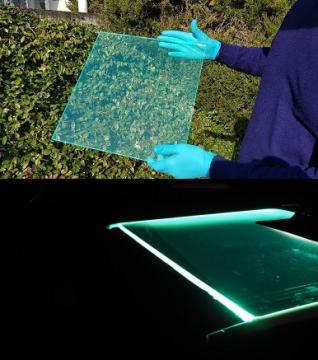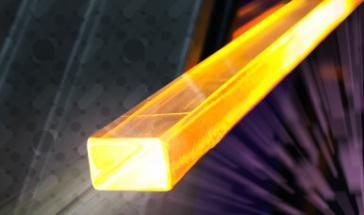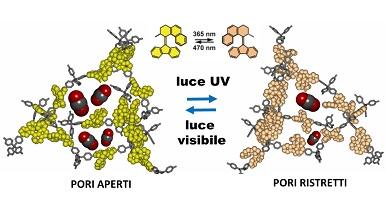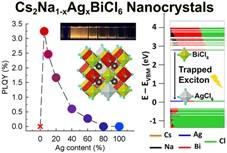Research Highlights 2020
Chemically Sustainable Large Stokes Shift Derivatives for High-Performance Large-Area Transparent Luminescent Solar Concentrators

The growing demand for building- integrated photovoltaic technologies for near-zero-energy buildings is motivating the scientific community to develop devices that meet the functional, energetic, and aesthetic needs for sustainable architecture. Luminescent solar concentrators (LSCs) are emerging as valuable solutions to realize aesthetically pleasing semitransparent photovoltaic windows capable of converting urban buildings into energy generators. In this work, we report on efficient, transparent LSCs based on a novel class of reabsorption-free derivatives synthesized through a solvent- free route that massively improves the sustainability factor with respect to the state of the art. Optical-grade polymeric LSCs are produced via industrial methods with an optical power efficiency as high as 3% despite their transparency in the visible region. These results represent an important step forward for sustainable solar glazing systems for environmentally friendly architecture.
Mattiello, S.; Sanzone, A.; Bruni, F.; Gandini, M.; Pinchetti, V.; Monguzzi, A.; Facchinetti, I.; Ruffo, R.; Meinardi, F.; Mattioli, G.; Sassi, M.; Brovelli, S.; Beverina, L. Chemically Sustainable Large Stokes Shift Derivatives for High-Performance Large-Area Transparent Luminescent Solar Concentrators. JOULE 9, 1988–2003 (2020).
Efficient, fast and reabsorption-free perovskite nanocrystal-based sensitized plastic scintillators

The urgency for affordable and reliable detectors for ionizing radiation in medical diagnostics, nuclear control and particle physics is generating growing demand for scintillator devices combining efficient scintillation, fast emission lifetime, high interaction probability with ionizing radiation and mitigated reabsorption losses in large-volume/high-density detectors. To date, the simultaneous achievement of all such features is still an open challenge. Here we realize this regime with poly(methyl methacrylate) nanocomposites embedding CsPbBr3 perovskite nanocrystals as sensitizers for a conjugated organic dye featuring a large Stokes shift and a fast emission lifetime in the red spectral region. Complete energy transfer from the nanocrystals to the dye under both X-rays and α-particle excitation results in highly stable radioluminescence with an efficiency comparable to that of commercial-grade inorganic and plastic scintillators; an ~3.4 ns emission lifetime, competitive with fast lanthanide scintillators; and reabsorption-free waveguiding for long optical distances.
Gandini, M.; Villa, I.; Beretta, M.; Gotti, C.; Imran, M.; Carulli, F.; Fantuzzi, E.; Sassi, M.; Zaffalon, M.; Brofferio, C.; Manna, L.; Beverina, L.; Vedda, A.; Fasoli, M.; Gironi, L.; Brovelli, S. Efficient, fast and reabsorption-free perovskite nanocrystal-based sensitized plastic scintillators. NATURE NANOTECHNOLOGY 15, 462–468 (2020).
High Photon Upconversion Efficiency with Hybrid Triplet Sensitizers by Ultrafast Hole-Routing in Electronic-Doped Nanocrystals

Low-power photon upconversion based on sensitized triplet–triplet annihilation is considered the most promising upward wavelength shifting technique to enhance the light-harvesting capability of solar devices. Colloidal nanocrystals (NCs) with conjugated organic ligands have been recently proposed to extend the light-harvesting capability of molecular absorbers. Key to their functioning is efficient energy transfer (ET) from the NC to the ligand’s triplet state that sensitize free annihilator moieties responsible for the upconverted emission. The ET efficiency is typically limited by parasitic processes, above all non radiative hole-transfer to the ligand HOMO molecular orbital. We demonstrate a new exciton-manipulation approach that enables loss-free ET by electronically doping CdSe NCs with gold impurities that introduce a hole-accepting intragap state above the HOMO energy of the ligands. Upon photoexcitation, the NC photoholes are rapidly routed to the Au-level, producing a long-lived bound exciton in perfect resonance with the ligand triplet. This hinders hole transfer leading to ≈100% efficient ET that translates into an upconversion quantum yield as high as ≈12% which is the highest performance for NC-based upconverters based on sTTA to date and approaches the efficiency of optimized organic systems.
Ronchi, A; Capitani, C; Pinchetti, V; Gariano, G; Zaffalon, ML; Meinardi, F; Brovelli, S; Monguzzi, A. High Photon Upconversion Efficiency with Hybrid Triplet Sensitizers by Ultrafast Hole-Routing in Electronic-Doped Nanocrystals. ADVANCED MATERIALS 32 (37), 200295332 (2020).
Fast motion of molecular rotors in metal–organic framework struts at very low temperatures

Hyper-fast dynamics in the solid matter at extremely cold temperatures is a challenge, because the reduction of thermal energy to negligeable amounts generally hampers any motion. By engineering chemical bonds so that they do not express resistance to rotation it is possible to realize molecular machines wherein hard and soft moieties play a well-defined and controllable role. A benchmark rotation (1010 Hz at 2 K) and an energy barrier of only 6.2 cal mol−1 was achieved by a bicyclopentane–dicarboxylate (BCP) struts in a zinc-based metal–organic framework (Zn-MOF).
The three-fold bipyramidal symmetry of the rotator frustrates the four-fold symmetry of the strut, allowing for the continuous, unidirectional, rotation for hundreds of turns, minimizing the effect of thermal noise. This opens up the way to realize coherent rotation in molecular motors within porous crystals and on crystalline surfaces.
Perego, J.; Bracco, S.; Negroni, M.; Bezuidenhout , C. X.; Prando, G.; Carretta, P.; Comotti, A.; Sozzani, P. Fast motion of molecular rotors in metal–organic framework struts at very low temperatures. NATURE CHEMISTRY 12, 845 (2020).
Modulation of porosity in a solid material enabled by bulk photoisomerization of an overcrowded alkene

The fabrication of responsive materials, the properties of which can be controlled on-demand, can be designed by incorporation of photoswitchable molecules into solid-state frameworks. We realized robust and covalent porous frameworks copolymerizing tetraphenylmethane with a bistable chiroptical overcrowded alkene. High intrinsic porosity enabled ready response to light stimuli. Solid-state 13C NMR spectroscopy highlighted a quantitative bulk photoisomerization. Taking advantage of the porosity of the framework active, CO2 adsorption can be reversibly modulated in response to light and heat. Thus, a versatile promising method to build active 3D polymer networks incorporating a variety of switches and motors could be proposed successfully.
Castiglioni, F.; Danowski , W.; Perego, J.; Leung, F. K.; Sozzani, P.; Bracco, S.; Wezenberg, S. J.; Comotti, A.; Feringa, B. L. Modulation of porosity in a solid material enabled by bulk photoisomerization of an overcrowded alkene. NATURE CHEMISTRY 12, 595 (2020).
Compositional Tuning of Carrier Dynamics in Cs2Na1–xAgxBiCl6 Double-Perovskite Nanocrystals

We devised a hot-injection synthesis to prepare colloidal double-perovskite Cs2NaBiCl6 nanocrystals (NCs). We also examined the effects of replacing Na+ with Ag+ cations by preparing and characterizing Cs2Na1–xAgxBiCl6 alloy NCs with x ranging from 0 to 1. Whereas Cs2NaBiCl6 NCs were not emissive, Cs2Na1–xAgxBiCl6 NCs featured a broad photoluminescence band at ∼690 nm, Stokes-shifted from the respective absorption by ≥1.5 eV. The emission efficiency was maximized for low Ag+ amounts, reaching ∼3% for the Cs2Na0.95Ag0.05BiCl6 composition. Density functional theory calculations coupled with spectroscopic investigations revealed that Cs2Na1–xAgxBiCl6 NCs are characterized by a complex photophysics stemming from the interplay of (i) radiative recombination via trapped excitons localized in spatially connected AgCl6–BiCl6 octahedra; (ii) surface traps, located on undercoordinated surface Bi centers, behaving as phonon-assisted nonradiative decay channels; and (iii) a thermal equilibrium between trapping and detrapping processes. These results offer insights into developing double-perovskite NCs with enhanced optoelectronic efficiency.
Zhu, D.; Zito, J.; Pinchetti, V.; Dang, Z.; Olivati, A.; Pasquale, L.; Tang, A.; Zaffalon, M.L.; Meinardi, F.; Infante, I.; De Trizio, L.; Manna, L.; Brovelli, S. Compositional Tuning of Carrier Dynamics in Cs2Na1–xAgxBiCl6 Double-Perovskite Nanocrystals. ACS ENERGY LETTERS 5 (6), 1840–1847 (2020).